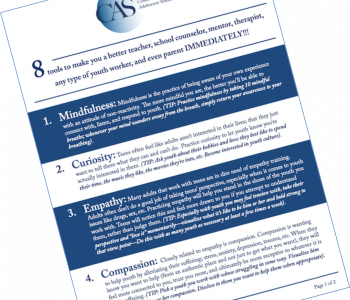

Catharine Hannay, MA
Catharine Hannay is the founder of MindfulTeachers.org and the author of Being You: A Girl’s Guide to Mindfulness, a workbook for teen girls on mindfulness, compassion, and self-acceptance.
Four Dos and Don’ts for Setting Effective Boundaries with Youth
“Wisdom is knowing when to employ the gentle compassion of understanding and when to employ the fierce compassion of good boundaries.”
Thich Nhat Hanh, Zen and the Art of Saving the Planet
If you work with youth in any capacity, there will inevitably be times when you’ll need to draw a line. This could be because:
- Their behavior is harmful to you, themselves, or others;
- They’re breaking an important rule or policy at your institution; or
- You simply aren’t able to give them what they need or want in that moment.
Melissa Urban outlines the three steps of boundary-making:
“1. Identify the need for a boundary.
- Set the boundary, using clear, kind language.
- Hold the boundary.
(The Book of Boundaries, p. 26)
Of course, this is easier said than done! Here are a few ‘dos and don’ts’ for handling the challenges of recognizing, setting, and enforcing limits with the youth under your care.
1. DON’T Expect Teens to Be Mind Readers
If you tell kids, “Feel free to drop by my office any time,” don’t be surprised if they keep hanging around your office all afternoon.
If you give them your cell phone number and tell them, “Call me whenever you have a question,” don’t be surprised if they call you late at night.
Young people don’t always have the life experience or common sense to see what might be obvious to an adult—like the college student who complained, “I keep trying to see you during your office hours, but you’re never there.” He saw that the hours were “Mon/Wed/Fri from 8-10” and kept showing up at nine p.m. instead of nine a.m.
It can also be confusing when different adults have different policies, or when the same adult seems to be changing the rules.
“We may provide an extra warm response one day […] and then feel annoyed another day when a young person expects a similar response and we just can’t be available in the same way. […]
Imagine how difficult it must be for adolescents to know what is appropriate. How must they feel when they are in our office sobbing one day, and the next day we interact with them in an official capacity and businesslike manner?”
(Rathbone and Baron, What Works with Teens, p. 87)
When it feels like someone has crossed the line, Britt Rathbone and Julie Baron suggest asking yourself these questions:
1. What is it, specifically, that the young person is doing that is crossing a line for me?
2. Have I allowed the adolescent to cross this or a similar boundary in the past3. Have I ever stated a limit around this in the past?”
(What Works with Teens, p. 112)
You may need to express very directly what your expectations are and what the consequences will be if they aren’t met.
Depending on your context, this could mean clearly explaining what will happen if they don’t turn in their homework or paperwork on time, if they don’t show up for a required meeting, or if they get into a fight with another youth.
“When an adolescent knows what will happen as a result of a behavior, it affords her an opportunity to make a choice. Knowing the potential consequences in advance also solidifies the adult’s position in holding the teen accountable.”
(What Works with Teens, p. 145)
2. DO Let Them Face the Consequences of Their Actions
A teacher told me she was concerned about her students doing a good job on their speeches, so she spent hours creating their PowerPoint outlines for them. She didn’t realize how ridiculous this was until her husband teased her, “Why don’t you cut out the middle man and give the presentations yourself?”
Contrast this with the conversation I overheard between a student and a professor at the end of the semester:
Student: “I have bad news about my paper.”
Professor: “Bad news for me, or bad news for you?”
The student didn’t have a legitimate reason for not finishing his paper on time. There was a clearly stated policy indicating the number of points taken off for late assignments. ‘Nuff said.
However. The way I’ve just described the situation is a bit deceptive. At the time, I was gobsmacked by my colleague’s calm, matter-of-fact response, since I’d been feeling sick with anxiety over a similar situation with one of my own students.
It was a useful lesson for me: When the rules are clear, and the consequences are clear, it’s okay to calmly sit back while someone faces those consequences. Especially when the stakes really aren’t that high in the grand scheme of things (as in, a lower grade, not anything life-threatening).
3. DO Be as Firm as You Need to Be
Psychologist Arthur Ciaramicoli had a patient who lied to him repeatedly and stole medications from the hospital. One day, he called with an emergency and convinced the switchboard operator it was serious enough to interrupt Dr. Ciaramicoli’s session with another patient.
“On the phone he explained his ‘emergency’—he had violated parole and needed me to write a letter to the court to bail him out. I was forceful with him, and when he kept pushing, I hung up on him.”
Dr. Ciaramicoli’s refusal was actually in the best interests of his patient, who needed to learn that he couldn’t manipulate his psychologist. As it turned out, it also helped the other patient, the one who witnessed the phone call:
“You hung up on that person!”
“He lied to me too many times.”
She asked, “If someone lies to you, you can cut him off?” and they started talking about when and how to set limits. This was a transformative series of conversations, since she’d been feeling trapped in an abusive relationship. (The Power of Empathy, p. 165)
4. DON’T React More Harshly Than Necessary
As Melissa Urban puts it, “Don’t use a flamethrower to kill mosquitoes.”
She provides a useful guideline to figuring out how firmly to respond when someone crosses the line:
“GREEN: Assumes the other person wasn’t aware they were overstepping and wants to respect your limits. Your boundary language is clear […] and very kind.”
YELLOW: Used as a follow-up if your Green boundary isn’t respected. […]Your boundary language is […] firm, and may also include an intended consequence, if appropriate.
RED: At this point, […] your language must reflect the severity of the situation. […] State the consequence plainly here and be ready to enforce it.”
(The Book of Boundaries, p. 52-54)
Conclusion
“What’s the new program director like?”
“She’s nice, but don’t try any B.S.”
(overheard conversation between two teens)
As you’ve probably noticed, what these four tips boil down to is finding the middle ground rather than going too far in one direction or the other and being overly lenient or inappropriately harsh.
If you’re struggling to find the right balance, think about:
- your personality and how you tend to react under stress (knowing your Enneagram type can help a lot with this);
- how you might be influenced by your own experiences with authority figures while you were growing up; and
- what’s ultimately in the interests of the youth under your care (as opposed to reacting out of your own frustration or discomfort).
You might find it helpful to discuss these issues with a trusted colleague.
And you can find more tips on setting limits in the following posts:
How Can I Focus on Self-Care When There’s Endless Need?
Mindful Classroom Management: A tried and true technique for getting youth back on track.
What Can I Do if a Youth Asks Me for Personal Information?
Why Setting Boundaries is Critical to Healthy Relationships with Teens

